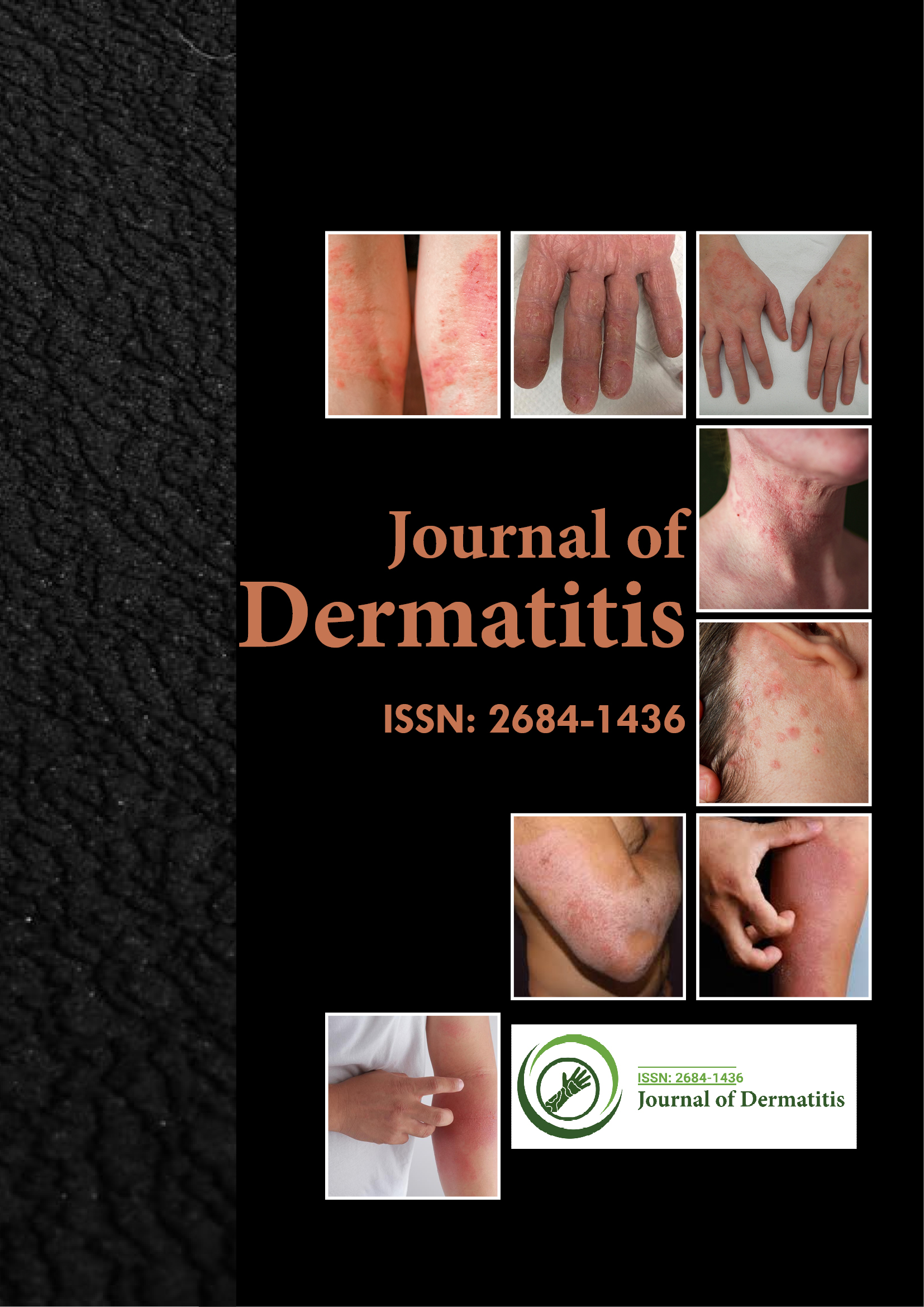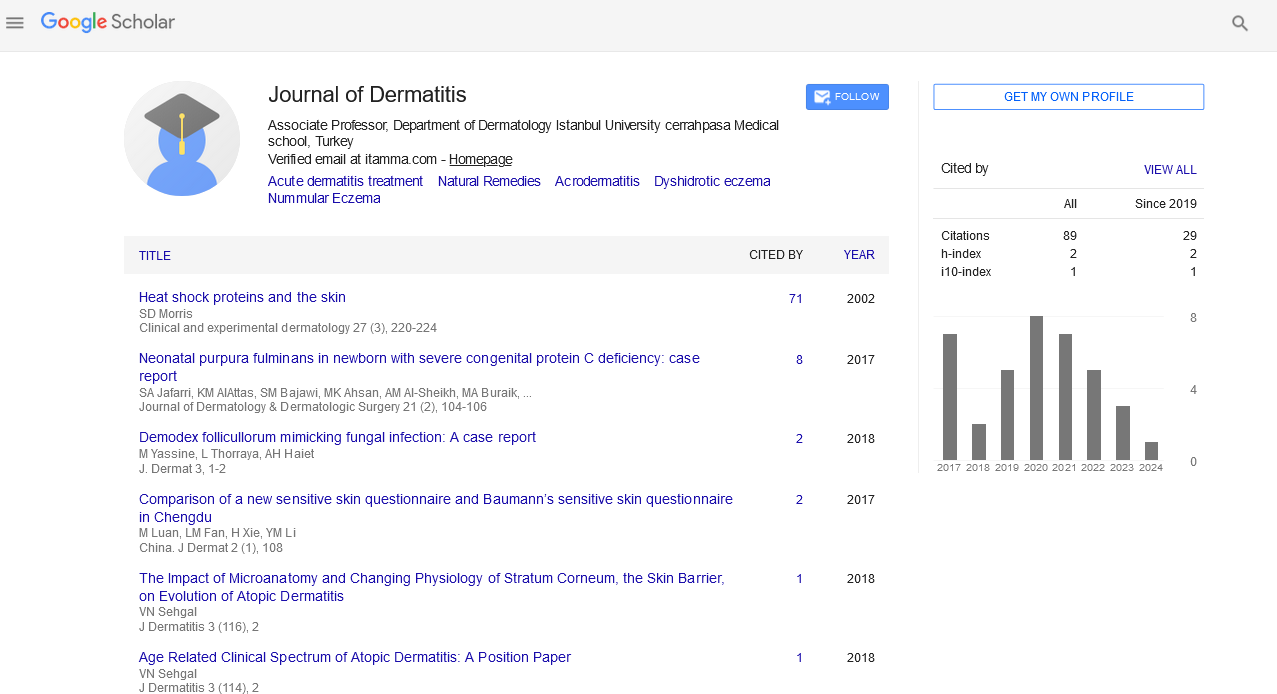Indexed In
- RefSeek
- Hamdard University
- EBSCO A-Z
- Euro Pub
- Google Scholar
Useful Links
Share This Page
Journal Flyer

Open Access Journals
- Agri and Aquaculture
- Biochemistry
- Bioinformatics & Systems Biology
- Business & Management
- Chemistry
- Clinical Sciences
- Engineering
- Food & Nutrition
- General Science
- Genetics & Molecular Biology
- Immunology & Microbiology
- Medical Sciences
- Neuroscience & Psychology
- Nursing & Health Care
- Pharmaceutical Sciences
Opinion Article - (2023) Volume 8, Issue 5
Pathways for Treating Lichenoid Dermatitis from Diagnosis to Recovery
Katarna Worser*Received: 17-Aug-2023, Manuscript No. JOD-23-23547; Editor assigned: 21-Aug-2023, Pre QC No. JOD-23-23547 (PQ); Reviewed: 04-Sep-2023, QC No. JOD-23-23547; Revised: 11-Sep-2023, Manuscript No. JOD-23-23547 (R); Published: 19-Sep-2023, DOI: 10.35248/2684-1436.23.8.217
Description
Lichenoid dermatitis, a skin condition characterized by red, itchy, and often scaly rashes, can be a frustrating and uncomfortable experience for those who suffer from it. Fortunately, there are several pathways for diagnosing and treating this condition, leading to a potential road to recovery. In this article, we will explore the journey from diagnosis to recovery for individuals dealing with lichenoid dermatitis.
Diagnosis
The first step on the pathway to treating lichenoid dermatitis is a proper diagnosis. This condition can mimic other skin disorders, such as psoriasis and eczema, making an accurate diagnosis crucial. Dermatologists typically begin by conducting a thorough physical examination and taking a detailed medical history. They may also perform a skin biopsy to confirm the presence of lichenoid dermatitis.
Identification of triggers
Once diagnosed, identifying potential triggers becomes the next step in the treatment process. Lichenoid dermatitis can be triggered by various factors, including medications, allergens, and infections.
Topical treatments
Topical treatments are often the first line of defense against lichenoid dermatitis. Topical calcineurin inhibitors, such as tacrolimus and pimecrolimus, can also be effective in managing the condition without the side effects associated with long-term corticosteroid use.
Oral medications
Systemic corticosteroids can provide relief from symptoms, but their use is generally limited due to potential side effects. Immunosuppressant drugs like methotrexate or cyclosporine are sometimes prescribed for long-term management of lichenoid dermatitis.
Phototherapy
Phototherapy, or light therapy, is another pathway to treat lichenoid dermatitis. Exposure to ultraviolet (UV) light can help reduce inflammation and improve the appearance of the skin. This treatment is typically administered under medical supervision and may be used in combination with topical or oral medications.
Biologics
In recent years, biologic medications have shown potential in treating lichenoid dermatitis. Biologics target specific molecules in the immune system responsible for inflammation. They are generally reserved for severe, refractory cases and require careful monitoring due to their potential side effects.
Lifestyle modifications
In addition to medical interventions, lifestyle modifications can significantly impact the pathway to recovery. Keeping the skin moisturized with emollients, taking lukewarm baths, and avoiding harsh soaps can help reduce irritation. Wearing loosefitting clothing made from natural fibers and managing stress through relaxation techniques can also be beneficial.
Follow-up care
Regular follow-up appointments with a dermatologist are essential to monitor the progress of treatment. Adjustments may be necessary, and any side effects or complications should be promptly addressed. Patients should actively communicate with their healthcare providers about their symptoms and treatment experiences.
Patient education
Understanding the condition and the treatment plan is vital for patients on the pathway to recovery. Healthcare providers should educate individuals about lichenoid dermatitis, its triggers, and how to manage the condition effectively. Patients need to be aware of potential side effects of medications and how to recognize signs of worsening symptoms.
Support networks
Living with lichenoid dermatitis can be emotionally challenging. Joining support groups or seeking counseling can provide emotional support and practical advice for coping with the condition. Sharing experiences and strategies with others who have lichenoid dermatitis can be invaluable.
Conclusion
Lichenoid dermatitis is a skin condition that requires a multifaceted approach to diagnosis and treatment. The pathway from diagnosis to recovery involves proper diagnosis, trigger identification, a combination of topical and systemic treatments, lifestyle modifications, follow-up care, patient education, and support networks. By following these pathways and working closely with dermatologists, individuals with lichenoid dermatitis can find relief and embark on their journey to recovery. While managing this condition may be challenging, the objective is to improve the quality of life and minimize the impact of lichenoid dermatitis on daily activities.
Citation: Worser K (2023) Pathways for Treating Lichenoid Dermatitis from Diagnosis to Recovery. J Dermatitis. 8:217.
Copyright: © 2023 Worser K. This is an open-access article distributed under the terms of the Creative Commons Attribution License, which permits unrestricted use, distribution, and reproduction in any medium, provided the original author and source are credited.

